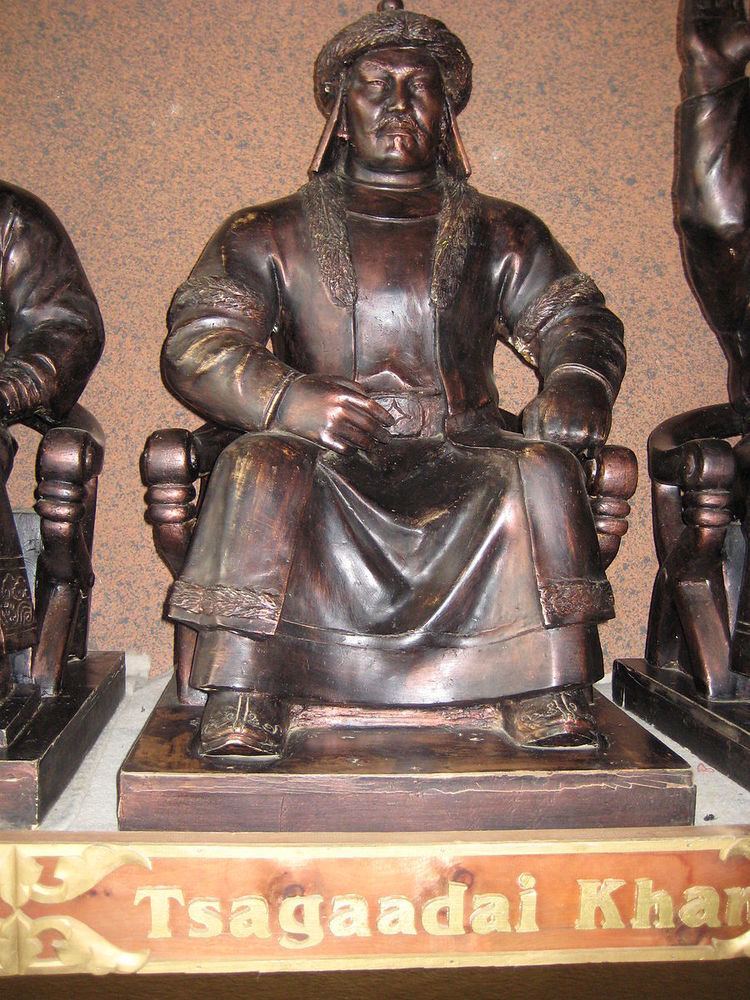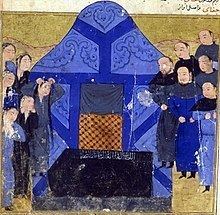Reign 1226 – 1241-42 Name Chagatai Khan Parents Genghis Khan, Borte | Successor Qara Hulegu Died 1241, Ghulja, China Role Crowned head | |
 | ||
Consort Yesulun KhatunTogan KhatunSevinch Khatun Issue MutukanBaidarYesu Mongke Siblings Ogedei Khan, Jochi Khan, Tolui Children Yesu Mongke, Baidar Khan, Mutukan Khan Similar People | ||
Chagatai khan top 5 facts
Chagatai Khan (Mongolian: Цагадай, Tsagadai; Chinese: 察合台, Chágětái; Turkish: Çağatay; Persian: جغتای, Joghatai , 22 December 1183 – 1 July 1242) was the second son of Genghis Khan. He was Khan of the Chagatai Khanate from 1226-1242 C.E. The Chagatai language and Chagatai Turks take their names from him. He inherited most of what are now the five Central Asian states after the death of his father. He was also appointed by Genghis Khan to oversee the execution of the Yassa, the written code of law created by Genghis Khan, though that lasted only until Genghis Khan was crowned Khan of the Mongol Empire. The Empire later came to be known as the Chagatai Khanate, a descendant empire of the Mongol Empire. Chagatai Khan was considered hot-headed and somewhat temperamental by his relatives, because of his attitude of non-acceptance of Jochi as Great Khan. He was the most vocal about this issue among his relations. Chaghatai himself appears to have been a just and energetic governor, though perhaps rough and uncouth, and addicted to hard drinking. At any rate, he was animated by the soldier-like spirit of his father, and succeeded in keeping order among as heterogeneous a population as a kingdom was ever composed of.
Contents
- Chagatai khan top 5 facts
- Administration and religious tolerance
- Family
- Mutukan
- Baidar
- Moucy
- Genealogy of Chaghatai Khanate
- References
Administration and religious tolerance

In 1232, when sedition showed itself at Bukhara, he acted with promptness, if with severity, and saved his country from a far-reaching calamity. He was, in all probability, an old-fashioned Mongol, for he stood by the Yassa and that he showed little favour to what was, at that time in his dominions, the comparatively new and rising religion of Islam. He must, however, have been fairly tolerant, for it is recorded that his minister for Transoxiana was a Muslim, called the Jumilat-ul-Mulk or Karachar Nevian, and that mosques and colleges were founded during his reign. Chaghatai was neither ever inclined towards Christianity, though that religion, as practiced by the Nestorians, must have been familiar to him.
Chaghatai's own capital was at Almaligh, in the valley of the Upper Ili, near the site of the present Kulja, and consequently in the extreme east of his dominion. His reason for fixing it in that remote position, instead of at Bukhara or Samarkand, was probably one of necessity. His Mongol tribesmen and followers;the mainstay of his power—were passionately fond of the life of the steppes. The dwellers in houses and towns were, in their eyes, a degenerate and effeminate race; the tillers of the soil, slaves who toiled like cattle, in order that their betters might pass their time in luxury. They would serve no Khan who did not pass a life worthy of free-born men and Chaghatai and his immediate successors probably saw, as his later descendants are described by Mirza Muhammad Haidar Dughlat to have seen, that the one way of retaining the allegiance of his own people, was to humour their desires in this respect, and live, with them, a nomad's life.
Family
Chaghatai died in 1241, after a reign of about fourteen years, and within the same year the death of Ogedai occurred at Karakorum. Thus two out of four of the chief divisions of the Mongol empire were suddenly deprived of their sovereigns, with the result that nearly the whole of the successors of Genghis Khan began disputing for the succession. However, for the time being, it ended in Turakina, Ogedai's widow, being appointed regent. But lasting disputes remained among the rival claimants and for long afterward, the disputes regarding the succession to the throne of the great Khan became inextricably mixed up with the affairs, especially in the eastern part, of Chaghatai's Khanate.
Little is known of the way in which Chaghatai disposed of his kingdom at his death, and there appears to be no mention, anywhere, of his having followed the ancestral custom of his house in distributing it among his descendants. He is recorded to have left a numerous family, but to have been succeeded by a grandson, and a minor, named Qara Hülëgü, while his widow, Ebuskun, assumed the regency.
Mutukan
Chagatai's son Mutukan (Mö'etüken) was killed during the siege of Bamiyan in 1221.
Turkistan, Transoxiana, and the adjacent regions were controlled directly by his descendents but not Kashghar, Yarkand, Khotan, Aksu, and the southern slopes of the Tian Shan mountains;or, in other words, to the province south of the line of the Tian Shan, which is called, in our times, Eastern Turkistan. As regards this province, Mirza Muhammad Haidar Dughlat says that it was given by Chaghatai, presumably at his death, to the clan or house of Dughlat, whose members were reckoned to be of the purest Mongol descent, and one of the noblest divisions of that people. The Dughlats were thus made hereditary chiefs, or Amirs, of the various districts of Eastern Turkistan, as far back as the time of Chaghatai, for it is chiefly on this incident that hinges the permanent division of the Chaghatai realm into two branches, at a later date.
Baidar
Baidar was the second son of Chagatai Khan. He participated in the European campaign ("The elder boys campaign" as it was known in Mongolia) with his nephew Büri from 1235-1241. He commanded the Mongol army assigned to Poland with Kadan and, probably, Orda Khan
Early in May 1241 they entered Moravia. Then they continued via Brno, to join Batu's main army in Hungary. The destruction in Poland, Silesia and Moravia was all much of the same kind.
In 1240 Baidar participated in the election of Güyük Khan in 1247.
Moucy
Moucy, second son of Chagatai, son-in-law to Batu (Batu Khan)
Moucy is mentioned by Giovanni da Pian del Carpine in his work History of Mongols whom we call Tatars (Ystoria Mongalorum). In Carpine's work Moucy controlled territory of left-bank Dnieper at the land of Comans (Cumans) and he was senior to Korenca (Kuremsa) who was on the right-bank.
Genealogy of Chaghatai Khanate
In Babr Nama written by Babur, Page 19, Chapter 1; described genealogy of his maternal grandfather Yunas Khan as:
Yunas Khan descended from Chaghatal Khan, the second son of Chlngiz Khan (as follows,) Yunas Khan, son of Wais Khan, son of Sher-'ali Aughldn, son of Muhammad Khan, son of Khizr Khwaja Khan, son of Tughluq-timur Khan, son of Aisan-bugha Khan, son of Dawa Khan, son of Baraq Khan, son of Yesuntawa Khan, son of Muatukan, son of Chaghatal Khan, son of Chingiz Khan.
"Chughtai Khanates" A research project by Dr Abdul Rauf Mughal
